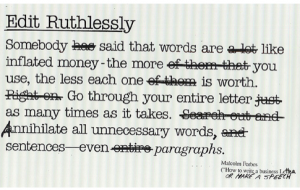I know you’re strapped for time. But that’s no excuse for slapping your communications together with the sole purpose of “getting them out there.” Why bother? Checking this task off your list (and maybe reporting to your boss and/or board that you did so) may make you feel a bit better. But it won’t help your readers (and potential supporters) feel good.
If you want to get gifts you must give them. Consider your communications a gift to your supporters. Don’t give something generic. Give something your recipient will appreciate. Ask yourself…
What’s in it for them? How does it help them? Entertain them? Reward them for taking the time to read what you’ve written? Make them want to open your gift?
Ah, yes. Don’t give them sloppy stuff. Wrap it up tidily and put a nice bow on it. Use headers, subtitles, indents, spacing, boldface, italics and underline to break up text and make it easy to grasp your important points. And please avoid shoddy grammar and spelling. If you appear careless, your reader will assume you’re careless about other things too – like how you might use their donation.
Have you ever sent something out to meet a deadline, only to discover a glaring typo when it was too late? I 100% recommend you use someone else on your staff as a proofreader (don’t just trust spellcheck; it misses a lot). But if you simply can’t, these tips will help you craft, double check and strategically edit your communications materials on your own.
Let’s begin with Rule #1 from Malcolm Forbes:
1. “Be crystal clear” and “Know what you want.”
Gosh dang it! How often have you written a letter, email, blog post or newsletter article without first really thinking about what you wanted as a specific outcome of that nice piece of communication you crafted? I don’t mean something general like “I want to create awareness for our cause.” Or even something like “I want this person to make a donation.” Something unambiguous like “I want you to know we give morning snacks to low-income kids at schools” or “I want you to give $25 to fund a week’s worth of snacks.” Mundane communications will get you mundane responses.
2. Look before you leap and plan before you write.
Don’t just start rambling. Spend 10 – 15 minutes making a quick outline of the one to three main points you want to make. You don’t want to end up with the kitchen sink. Dumping in whatever you’ve got results in a big mess.
3. Get to the point right away.
People have very little patience today. If they don’t see the purpose of your prose immediately, they won’t read the rest. In fact, I often find that folks inadvertently bury their lead down in about the third paragraph – so check there and see if that’s where you’ve put your really important stuff. And if you’re asking folks for money, don’t be gingerly about it. Don’t bury your lead.
4. Write the way you talk.
This is HUGE. I don’t care if your audience is a bunch of academics or lawyers who like using big words. You’re not writing a term paper or a legal brief. And chances are good your readers – even the highly literate and educated ones – don’t talk that way. And if you make them work – or think – too hard to read your communications, you’re going to lose them. Write between a 6th and 8th grade level. I’m serious.
5. Avoid jargon.
I add this to tip #4 above. Jargon is code language. It’s cold, unnatural, formal and even clinical. You may use it internally, but don’t use it outside your borders. It may seem to be a perfectly ‘normal,’ everyday word to you. But would your best friend really understand what it means? Jargon is bad because it deters understanding.Read your prose out loud before you publish it. If it feels awkward it will read awkward.
6. Lean heavier on nouns and verbs, lighter on adjectives and adverbs; Use the active, not passive, voice.
Which is better? “It would be greatly appreciated were you to consider a gift” or “Please give.” There’s a simple online tool called “Hemingway” that can help you with this, or you can use the Flesh-Kincaid reading level tool that comes with Microsoft Word. Simplify as much as you can.
7. Take a break before you edit.
Sometimes I’ll come back the next morning to something I’ve written and think “Whoa! I must’ve been really tired.” Other times I’ll think “Wow! That’s pretty good.” I can only assess my writing a bit after the fact. In the moment of the writing I just don’t know. Give yourself a little time to get away from your material. You’ll be more likely to spot the good stuff, making it easier to eliminate the bad. And you’ll spot typos more easily as well.
8. Edit the big picture first.
Before you agonize over every word in every paragraph, take a holistic look at what you’ve written. Is it what you wanted to say? Is it simple, short and to the point? Or have you included too many ideas? Or repeated ideas? Don’t waste time editing paragraphs that you should scrap in their entirety.
9. Shorten your introduction.
As I noted in tip #3, it’s too easy to bury the lead. So look at your opening paragraphs and see if you really need them. Do they hook your reader and encourage them to read on? To learn more about writing good hooks, see How to Write Irresistible Blog Intros. Keep in mind: first impressions count.
10. Sum it up. Always include a call to action.
Yes, always. It can be direct or indirect, but your communication must have a clear purpose. Your last paragraph or sentence should leave the donor with their gift for persevering. They should walk away with something. Maybe it’s a feeling or emotional response or a light bulb moment. If you want them to learn something, make sure to drive the point home. Maybe it’s a “to do” item. It doesn’t always have to be “donate.” Consider “comment,” “your feedback is appreciated,” “what else would you like to learn?” or “please send us a photo showing us how much you love _____.” Or your call to action can be subtly hidden from the reader. Perhaps your intent is to make your reader laugh. Or cry. Or feel angry. Or inspired. Just be intentional in all your writing.
Which of these 10 tips will you now start to use? Do you have others? Please share in the comments.








Excellent suggestions, Claire. These tips would make a great infographic to hang on cubicle walls. In addition to a visual cue like that, we work with our clients to include an evaluation cycle in every campaign, which in turn includes every communication. Each evaluation concludes with a simple (but often difficult to swallow) designation of “successful”, “not successful”, or “unable to determine” which eventually rolls up to an annual performance report.
While there’s always the pressure to slap something together and getting it out there, this system encourages them to be thoughtful about how they approach each new communication. Thanks for sharing!
PS, Yesterday (http://goo.gl/pZBNom) I shared in a post that jargon might be appropriate in cases where doing so will help build a stronger connection with an “in the know” group. I’m assuming this group would be considered “inside your borders”.
Thanks so much Lance. And I enjoyed your jargon post. 🙂
I think it’s important to remember that almost no one is as “in the know” as we imagine them to be. Generally, only staff live and breathe the mission on a daily basis. It’s not uncommon for me to find that board members really don’t understand the depth and breadth of what their organization does. They may pretend to, but using simpler language even with them generally can’t hurt. No one wants to admit they don’t understand what you’re talking about.
Thanks Claire! Too true. Often even the staff isn’t as aware as they could/should be. Keep up the great work!